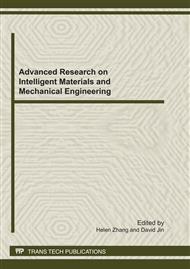[1]
G. S. Beavers, D.D. Joseph, Boundary Conditions at a Naturally Permeable Wall[J], J. Fluid Mech, 30(1), 197–207, (1967).
DOI: 10.1017/s0022112067001375
Google Scholar
[2]
J. A. Ochoa-Tapia, S. Whitaker, Momentum Transfer at the Boundary Between a Porous Medium and a Homogeneous Fluid-I. Theoretical Development[J], Int. J. Heat Mass Transfer, 38(4), 2635-2646, (1995).
DOI: 10.1016/0017-9310(94)00346-w
Google Scholar
[3]
J. A. Ochoa-Tapia, S. Whitaker, Momentum Transfer at the Boundary between a Porous Medium and a Homogeneous Fluid-II. Comparison with Experiment[J], Int. J. Heat Mass Transfer, 38(14), 2647-2655, (1995).
DOI: 10.1016/0017-9310(94)00347-x
Google Scholar
[4]
M. Khakpour, K. Vafai, Analysis of Transport Phenomena within PEM Fuel Cells–An Analytical Solution[J], Int. J. Heat Mass Transfer, 51(15-16), 3712–3723, (2008).
DOI: 10.1016/j.ijheatmasstransfer.2007.12.013
Google Scholar
[5]
A. C. Baytas, A. F. Baytas, D. B. Ingham, I. Pop, Double Diffusive Natural Convection in an Enclosure Filled with a Step Type Porous Layer: Non-Darcy Flow[J], International Journal of Thermal Sciences, 48(4), 665–673, (2009).
DOI: 10.1016/j.ijthermalsci.2008.06.001
Google Scholar
[6]
H. C. Chan, W. C. Huang, J. M. Leu, C. J. Lai, Macroscopic Modeling of Turbulent Flow over a Porous Medium[J], Int. J. Heat and Fluid Flow, 28(5), 1157–1166, (2007).
DOI: 10.1016/j.ijheatfluidflow.2006.10.005
Google Scholar
[7]
C. Deng, D. M. Martinez, Viscous Flow in a Channel Partially Filled with a Porous Medium and Withwall Suction[J], Chemical Engineering Science, 60(2), 329–336, (2005).
DOI: 10.1016/j.ces.2004.08.010
Google Scholar
[8]
H. Tan, K. M. Pillai, Finite Element Implementation of Stress-jump and Stress-continuity Conditions at Porous-medium[J], Clear-fluid Interface, Computers & Fluids, 38(6), 1118-1131, (2009).
DOI: 10.1016/j.compfluid.2008.11.006
Google Scholar
[9]
M. Mishra, A. R. Rao, Peristaltic Transport in a Channel with a Porous Peripheral Layer: Model of a Flow in Gastrointestinal Tract[J], Journal of Biomechanics, 38(4), 779–789, (2005).
DOI: 10.1016/j.jbiomech.2004.05.017
Google Scholar
[10]
X. B. Chen, P. Yu, Y. Sui, S. H. Winots, H. T. Low, Natural convection in a cavity filled with porous layers on the top and bottom walls[J], Transp Porous Med, 78:, 259-276, (2009).
DOI: 10.1007/s11242-008-9300-2
Google Scholar


